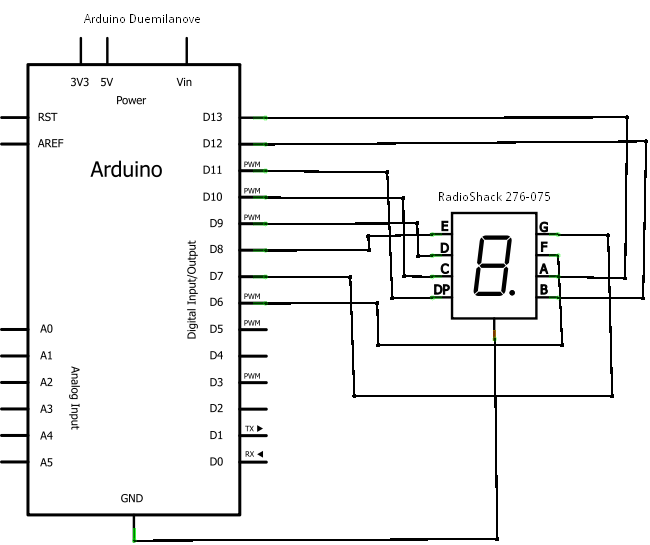
Multi-Colour LED

How many different conditions can be indicated with just one LED? Two, perhaps three? Using this simple circuit, many more can be signaled! This circuit employs a two-color LED, which consists of two light-emitting chips, typically red and green, encapsulated in the same package. It has three pins: two for the anodes and one for the common cathode. This configuration allows each diode to be activated independently. By varying the current through the two diodes, various mixed colors can be produced, resulting in at least four distinct colors: pure red, pure green, orange (IR ≈ 2IG), and yellow (IG ≈ 2IR). In the present circuit, the LED elements are driven by CMOS three-state buffers of type 4503, which, unlike most CMOS ICs from the 4000 series, can supply up to 10 mA of output current. The LED currents are limited by resistors R1 through R6, whose values can be adjusted to experiment with brightness and colors according to personal preference. The circuit was originally designed to indicate the state of three inputs, a, b, and c (non-binary, meaning only one of these can be at 1 at any time), with the configuration (a=b=c=0) representing the fourth state. This state is decoded by NAND gate IC1. An additional effect is created by gates IC1a and IC1b, which are configured into an oscillator circuit generating approximately two pulses per second. These pulses control the common-enable input, DA (pin 1) of the 4503, producing a flickering effect. The oscillator is controlled via inputs d' and e'. When both inputs are pulled high, the oscillator and the LED driver are disabled. With e=0 and d=1, the outputs of the 4503 switch to three-state, placing the circuit in power-down standby mode. Although designed for a 12-V supply voltage, the circuit operates effectively at any supply voltage between 5 V and 16 V. Unused inputs of CMOS ICs should be connected to ground through 10-100 kΩ resistors.
The circuit utilizes a two-color LED to signal multiple conditions through a simple yet effective design. The LED, comprising red and green diodes, allows for independent activation, enabling the generation of various colors based on the current supplied to each diode. This flexibility permits the observation of distinct colors, including orange and yellow, achieved by manipulating the current ratios.
The CMOS 4503 three-state buffers serve as the driving mechanism for the LED, providing sufficient output current to illuminate the diodes effectively. Current limiting is accomplished through resistors R1 to R6, offering a practical means to customize brightness and color intensity. This feature encourages experimentation, allowing users to tailor the visual output to specific preferences.
The circuit's logic is designed to interpret three input states, ensuring that only one input can be active at any time, while the fourth state is represented by all inputs being low. The NAND gate, IC1, plays a crucial role in decoding these states, facilitating the correct LED illumination based on input conditions.
An oscillator circuit composed of gates IC1a and IC1b introduces a dynamic flickering effect, enhancing the visual feedback provided by the LED. This oscillator operates at a frequency of approximately two pulses per second, controlled by the inputs d' and e'. The design incorporates a power-saving mode, allowing the circuit to enter a standby state when specific conditions are met, thereby reducing power consumption during inactivity.
The circuit is versatile in terms of supply voltage, functioning effectively within a range of 5 V to 16 V, which broadens its application potential. Proper handling of unused inputs is essential to prevent erratic behavior, and connecting them to ground via appropriate resistors ensures stable operation. Overall, this circuit exemplifies an innovative approach to signaling multiple conditions using a single LED, leveraging the capabilities of modern CMOS technology.How many different conditions do you reckon may be signalled with just one LED Two, maybe three Using this simple circuit, a lot more! Admittedly, a two-colour LED is used here. Such a device consists of two light-emitting chips, usually red and green, encapsulated in the same case.
It has three pins: two for the anodes, and one for the common c athode. In this way, each diode can be activated separately. Various mixed colours may be obtained by varying the current through the two diodes. At least four discrete colours are then easily perceived: pure red, pure green, orange (IR ‰ 2IG) and yellow (IG ‰ 2IR). In the present circuit, the LED elements are driven by CMOS three-state buffers type 4503, which, unlike most CMOS ICs from the 4000 series, are capable of supplying up to 10 mA of output current.
The LED currents are limited by resistors R1 through R6, whose values invite experiments with brightness and colours according to your own taste. The circuit was originally developed to indicate the state of three inputs, a, b, and c (non-binary, i.
e. , only one of these is at 1 at any time), with the configuration (a=b=c=0) representing the fourth state. The latter is decoded by NAND gate IC1. An additional effect is produced by gates IC1a and IC1b, which are connected up into an oscillator circuit producing approximately two pulses per second.
These pulses are used to control the common-enable input, DA (pin 1) of the 4503, so as to produce a flickering effect. The oscillator is controlled by means of inputs d` and e`. Pulling both of these logic high disables the oscillator and the LED driver. With e=0 and d=1 the outputs of the 4503 are switched to three-state, and the circuit is in power-down standby mode.
Although designed for a 12-V supply voltage, the circuit will happily work at any supply voltage between 5 V and 16 V. Non-used inputs of CMOS ICs must, of course, be tied to ground via 10-100 kW resistors. 🔗 External reference
The circuit utilizes a two-color LED to signal multiple conditions through a simple yet effective design. The LED, comprising red and green diodes, allows for independent activation, enabling the generation of various colors based on the current supplied to each diode. This flexibility permits the observation of distinct colors, including orange and yellow, achieved by manipulating the current ratios.
The CMOS 4503 three-state buffers serve as the driving mechanism for the LED, providing sufficient output current to illuminate the diodes effectively. Current limiting is accomplished through resistors R1 to R6, offering a practical means to customize brightness and color intensity. This feature encourages experimentation, allowing users to tailor the visual output to specific preferences.
The circuit's logic is designed to interpret three input states, ensuring that only one input can be active at any time, while the fourth state is represented by all inputs being low. The NAND gate, IC1, plays a crucial role in decoding these states, facilitating the correct LED illumination based on input conditions.
An oscillator circuit composed of gates IC1a and IC1b introduces a dynamic flickering effect, enhancing the visual feedback provided by the LED. This oscillator operates at a frequency of approximately two pulses per second, controlled by the inputs d' and e'. The design incorporates a power-saving mode, allowing the circuit to enter a standby state when specific conditions are met, thereby reducing power consumption during inactivity.
The circuit is versatile in terms of supply voltage, functioning effectively within a range of 5 V to 16 V, which broadens its application potential. Proper handling of unused inputs is essential to prevent erratic behavior, and connecting them to ground via appropriate resistors ensures stable operation. Overall, this circuit exemplifies an innovative approach to signaling multiple conditions using a single LED, leveraging the capabilities of modern CMOS technology.How many different conditions do you reckon may be signalled with just one LED Two, maybe three Using this simple circuit, a lot more! Admittedly, a two-colour LED is used here. Such a device consists of two light-emitting chips, usually red and green, encapsulated in the same case.
It has three pins: two for the anodes, and one for the common c athode. In this way, each diode can be activated separately. Various mixed colours may be obtained by varying the current through the two diodes. At least four discrete colours are then easily perceived: pure red, pure green, orange (IR ‰ 2IG) and yellow (IG ‰ 2IR). In the present circuit, the LED elements are driven by CMOS three-state buffers type 4503, which, unlike most CMOS ICs from the 4000 series, are capable of supplying up to 10 mA of output current.
The LED currents are limited by resistors R1 through R6, whose values invite experiments with brightness and colours according to your own taste. The circuit was originally developed to indicate the state of three inputs, a, b, and c (non-binary, i.
e. , only one of these is at 1 at any time), with the configuration (a=b=c=0) representing the fourth state. The latter is decoded by NAND gate IC1. An additional effect is produced by gates IC1a and IC1b, which are connected up into an oscillator circuit producing approximately two pulses per second.
These pulses are used to control the common-enable input, DA (pin 1) of the 4503, so as to produce a flickering effect. The oscillator is controlled by means of inputs d` and e`. Pulling both of these logic high disables the oscillator and the LED driver. With e=0 and d=1 the outputs of the 4503 are switched to three-state, and the circuit is in power-down standby mode.
Although designed for a 12-V supply voltage, the circuit will happily work at any supply voltage between 5 V and 16 V. Non-used inputs of CMOS ICs must, of course, be tied to ground via 10-100 kW resistors. 🔗 External reference
Warning: include(partials/cookie-banner.php): Failed to open stream: Permission denied in /var/www/html/nextgr/view-circuit.php on line 713
Warning: include(): Failed opening 'partials/cookie-banner.php' for inclusion (include_path='.:/usr/share/php') in /var/www/html/nextgr/view-circuit.php on line 713





